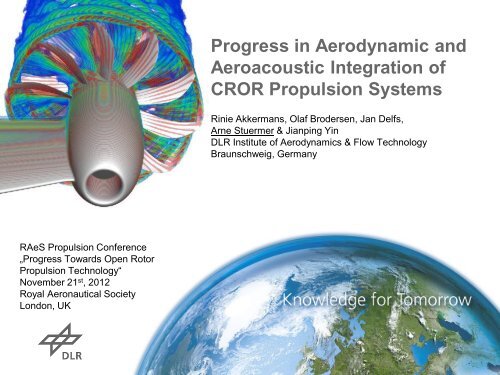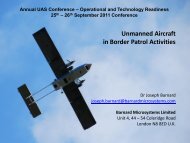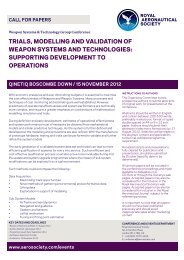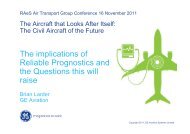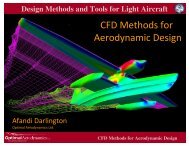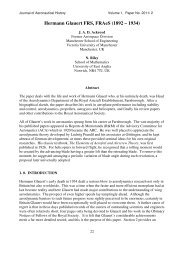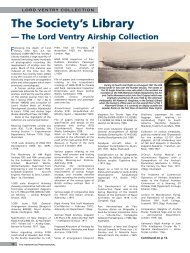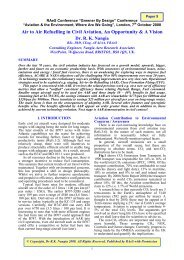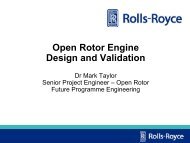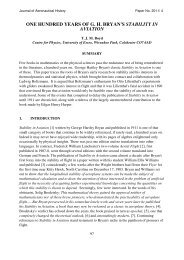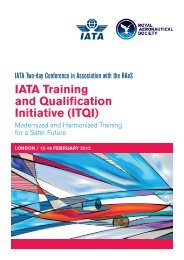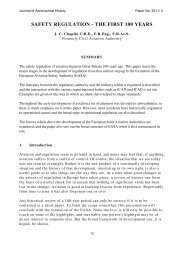Progress in Aerodynamic and Aeroacoustic Integration of CROR ...
Progress in Aerodynamic and Aeroacoustic Integration of CROR ...
Progress in Aerodynamic and Aeroacoustic Integration of CROR ...
Create successful ePaper yourself
Turn your PDF publications into a flip-book with our unique Google optimized e-Paper software.
www.DLR.de • Chart 1<br />
RAeS Propulsion Conference<br />
„<strong>Progress</strong> Towards Open Rotor<br />
Propulsion Technology“<br />
November 21 st , 2012<br />
Royal Aeronautical Society<br />
London, UK<br />
<strong>Progress</strong> <strong>in</strong> <strong>Aerodynamic</strong> <strong>and</strong><br />
<strong>Aeroacoustic</strong> <strong>Integration</strong> <strong>of</strong><br />
<strong>CROR</strong> Propulsion Systems<br />
R<strong>in</strong>ie Akkermans, Olaf Brodersen, Jan Delfs,<br />
Arne Stuermer & Jianp<strong>in</strong>g Y<strong>in</strong><br />
DLR Institute <strong>of</strong> <strong>Aerodynamic</strong>s & Flow Technology<br />
Braunschweig, Germany
www.DLR.de • Chart 2<br />
Propeller & <strong>CROR</strong> @ DLR-AS<br />
- History <strong>of</strong> experimental & numerical analysis,<br />
design & test<strong>in</strong>g <strong>of</strong> propellers & helicopters<br />
- CFD-based propeller analysis experience built up<br />
dur<strong>in</strong>g the past 9 years<br />
- Cooperation with Airbus on S<strong>in</strong>gle Rotation<br />
Propeller-related topics<br />
- CESAR: Cost Effective Small AiRcraft (Q4/2006-<br />
Q1/2010)<br />
- Contribution to Piaggio led Task<br />
“Environmentally Friendly Propeller<br />
Propulsion”<br />
- Low-noise high efficiency propeller-airframe<br />
<strong>in</strong>tegration<br />
- <strong>CROR</strong> activities s<strong>in</strong>ce 2007: Internal research,<br />
Airbus contracts (2008-present), Lufo-IV OPERO<br />
project with RR (2009-2012), EU-JTI SFWA<br />
activities (2008-present)
www.DLR.de • Chart 3<br />
Recent Applications:<br />
Internal Research Activities on <strong>CROR</strong> Installation Effects<br />
Arne Stuermer & Dr. Jianp<strong>in</strong>g Y<strong>in</strong><br />
DLR Institute <strong>of</strong> <strong>Aerodynamic</strong>s & Flow Technology<br />
Braunschweig, Germany
www.DLR.de • Chart 4<br />
Research Geometry:<br />
Siz<strong>in</strong>g, Nacelle <strong>and</strong> Pylon<br />
- Generic pusher <strong>CROR</strong>, sized for 150-seat AC:<br />
- TO-thrust Fx=88kN - Cruise thrust Fx=19kN @ design po<strong>in</strong>t<br />
M=0.75 @ h=35,000ft<br />
- 10-bladed D=4.2672m front rotor, 8-bladed<br />
aft rotor with 15% diameter crop<br />
- Generic pylon:<br />
- Symmetric airfoil, t/c=0.1<br />
- Untwisted for semi-<strong>in</strong>stalled case<br />
- x/D=0.15 distance to front rotor<br />
- Representative performance levels achieved:<br />
Cruise Performance <strong>of</strong> 10F2x8AC1 <strong>CROR</strong><br />
M=0.75 @ h=35,000ft; J1=3.678, J2=4.203 Rotor 1 Rotor 2 Total<br />
Fx [N] 10,566 8,424 18,990<br />
η [%] 79.72 91.98 85.85<br />
- Previous systematic configuration studies reported <strong>in</strong> AIAApapers<br />
2008-5218, 2009-3134, 2010-4235
www.DLR.de • Chart 5<br />
<strong>Aerodynamic</strong> Analysis:<br />
Installation Impact on Blades<br />
- Installation leads to non-uniform <strong>in</strong>flow for front rotor:<br />
- Pylon wake leads to localized <strong>in</strong>crease <strong>in</strong> AoA<br />
- Aircraft <strong>in</strong>cidence angle further distorts rotor <strong>in</strong>flow<br />
→Blade effective angle <strong>of</strong> attack variations<br />
- Overlapp<strong>in</strong>g impact <strong>of</strong> blade-blade <strong>in</strong>teractions
www.DLR.de • Chart 6<br />
The Case for Counter-Rotation <strong>of</strong> Installed Contra-<br />
Rotat<strong>in</strong>g Open Rotor Propulsion Systems<br />
Arne Stuermer & Jianp<strong>in</strong>g Y<strong>in</strong><br />
DLR Institute <strong>of</strong> <strong>Aerodynamic</strong>s & Flow Technology<br />
Braunschweig, Germany<br />
From: AIAA2012-2785<br />
30th AIAA Applied <strong>Aerodynamic</strong>s Conference<br />
June 25th, 2012<br />
New Orleans, LA
www.DLR.de • Chart 7<br />
Introduction & Motivation:<br />
Non-H<strong>and</strong>ed <strong>CROR</strong>s - Asymmetric Aircraft<br />
- Most likely eng<strong>in</strong>e-airframe <strong>in</strong>tegration scenario for empennage-mounted pusher<br />
<strong>CROR</strong> on notional T-tail aircraft configuration:<br />
- Same sense <strong>of</strong> <strong>CROR</strong> rotor rotation on both sides <strong>of</strong> the aircraft<br />
- Asymmetric aircraft <strong>and</strong> asymmetric aerodynamic <strong>and</strong> aeroacoustic <strong>CROR</strong><br />
performance due to complex <strong>in</strong>stallation effects
www.DLR.de • Chart 8<br />
<strong>Aerodynamic</strong> Analysis: Installation Impact on Blades<br />
- Aft blade shows full span<br />
unsteady load<strong>in</strong>gs due to<br />
front rotor wake<br />
imp<strong>in</strong>gement<br />
- Pylon wake impact<br />
<strong>in</strong>duced load<strong>in</strong>g jump for<br />
both rotor blades<br />
- Aft blade shows tip vortex<br />
imp<strong>in</strong>gement on upward<br />
sweep: Front blades<br />
load<strong>in</strong>g <strong>in</strong>crease on<br />
downward sweep affects<br />
blade wake <strong>and</strong> tip vortex<br />
strength <strong>and</strong> trajectory<br />
UBP @ α=4º
www.DLR.de • Chart 9<br />
<strong>Aerodynamic</strong> Analysis:<br />
Impact on Front Blades<br />
- Spectral analysis <strong>of</strong> blade load<strong>in</strong>g oscillations<br />
shows dom<strong>in</strong>ance <strong>of</strong> pylon wake imp<strong>in</strong>gement at<br />
rotor rotational frequency <strong>of</strong> f=n<br />
- Clear AoA-driven 1P-load<strong>in</strong>g <strong>in</strong>creases<br />
- Clear sense <strong>of</strong> rotation dependence <strong>of</strong> 1P<br />
load<strong>in</strong>g amplitude<br />
- Front rotor DBP sense <strong>of</strong> rotation:<br />
Superposition <strong>of</strong> pylon wake imp<strong>in</strong>gement<br />
with AoA-<strong>in</strong>duced load<strong>in</strong>g rise <strong>in</strong>creases<br />
overall amplitude <strong>of</strong> unsteady load<strong>in</strong>g<br />
- Critical eng<strong>in</strong>e <strong>in</strong> terms <strong>of</strong> blade lifetimes<br />
- Rotor-rotor <strong>in</strong>teraction:<br />
- Blade load<strong>in</strong>g oscillations at even number<br />
higher harmonics <strong>of</strong> aft rotors BPF<br />
- Front rotor blades show only small impact <strong>of</strong><br />
AoA <strong>in</strong>crease
www.DLR.de • Chart 10<br />
Low-Speed <strong>Aerodynamic</strong>s: Rotor 1P-Loads<br />
- Non-uniform <strong>in</strong>flow leads to 1P-loads, an important consideration for structural design &<br />
h<strong>and</strong>l<strong>in</strong>g qualities<br />
- <strong>CROR</strong> @ α=4º: Lift-dom<strong>in</strong>ated 1P-loads<br />
- UBP: 4.01% <strong>and</strong> 6.76% <strong>of</strong> front <strong>and</strong> aft rotor thrust respectively<br />
- DBP: 5.60% <strong>and</strong> 5.56% <strong>of</strong> front <strong>and</strong> aft rotor thrust respectively<br />
- Lateral <strong>and</strong> longitud<strong>in</strong>al trim required<br />
- Flight control system h<strong>and</strong>l<strong>in</strong>g <strong>of</strong> dynamic asymmetric 1P-loads dur<strong>in</strong>g maneuvers
www.DLR.de • Chart 11<br />
<strong>Aeroacoustic</strong> Analysis:<br />
Tools & Approach<br />
- Noise radiation analysis us<strong>in</strong>g DLR FW-H<br />
Code APSIM (Acoustic Prediction System<br />
based on Integral Method) for farfield noise<br />
predictions<br />
- Permeable surface approach used based<br />
on nacelle Chimera data:<br />
- Analysis for farfield polar microphone<br />
arrays @ 10D from front rotor center<br />
- Flyover noise simulation us<strong>in</strong>g DLR<br />
HEMISPHERE-Code:<br />
- Simulation for tw<strong>in</strong>-<strong>CROR</strong> powered<br />
aircraft fly<strong>in</strong>g at constant speed <strong>of</strong><br />
M=0.2, constant altitude <strong>of</strong> h=150m<br />
<strong>and</strong> constant (<strong>CROR</strong>)-AoA <strong>of</strong> α=4º<br />
over rectangular area <strong>of</strong> 1200x500m<br />
- Comparison <strong>of</strong> co-rotat<strong>in</strong>g <strong>CROR</strong> (left<br />
DBP, right UBP) <strong>and</strong> counter-rotat<strong>in</strong>g<br />
UBP <strong>CROR</strong> <strong>in</strong>stallation<br />
Perturbation<br />
Nearfield<br />
CFD<br />
APSIM<br />
(Blade) Surface<br />
Pressure
www.DLR.de • Chart 12<br />
<strong>Aeroacoustic</strong> Analysis:<br />
Farfield Polar Directivities<br />
- Farfield polar directivities show <strong>CROR</strong>characteristic<br />
flat noise directivities<br />
- Rotor tones dom<strong>in</strong>ate near planes <strong>of</strong><br />
rotation<br />
- Pylon wake imp<strong>in</strong>gement leads to front<br />
rotor tone <strong>in</strong>creases <strong>in</strong> upstream arc<br />
- Strong <strong>in</strong>teraction tone contributions <strong>in</strong><br />
the up- <strong>and</strong> downstream arc<br />
- Higher (front rotor) blade load<strong>in</strong>gs cause for<br />
most <strong>of</strong> the DBP cases noise penalty<br />
versus the UBP sense <strong>of</strong> front rotor rotation<br />
- UBP case shows higher upstream front<br />
rotor tone levels, possibly due to stronger<br />
pylon wake<br />
- Acoustically optimum sense <strong>of</strong> rotation<br />
<strong>of</strong> the (front) rotors with respect to the<br />
pylon (here: UBP) for community noise
www.DLR.de • Chart 13<br />
<strong>Aeroacoustic</strong> Analysis:<br />
Flyover Noise Analysis<br />
- Flyover noise contours show asymmetry for<br />
<strong>CROR</strong> co-rotation, with amplified secondary<br />
noise peaks <strong>in</strong> sidel<strong>in</strong>e direction vs. counterrotat<strong>in</strong>g<br />
<strong>CROR</strong> case<br />
- Effective Perceived Noise Level accounts for tone<br />
peak levels, annoyance as well as duration <strong>of</strong><br />
exposure to levels near peak, which lead to<br />
strong weight<strong>in</strong>g <strong>of</strong> <strong>in</strong>teraction tones<br />
- Aft rotor tone fundamental has lowest<br />
frequency <strong>and</strong> directivities important primarily<br />
<strong>in</strong> plane <strong>of</strong> rotors<br />
- Front rotor tone levels have highest peak<br />
levels, higher frequency content but still<br />
relatively focused directivities<br />
- Interaction tones have high frequency<br />
content, relatively high peak levels <strong>and</strong> flat<br />
directivities (long exposure times)
www.DLR.de • Chart 14<br />
Pylon Trail<strong>in</strong>g Edge Blow<strong>in</strong>g for the Control <strong>of</strong> <strong>CROR</strong><br />
Unsteady Blade Loads<br />
Arne Stuermer & Jianp<strong>in</strong>g Y<strong>in</strong><br />
DLR Institute <strong>of</strong> <strong>Aerodynamic</strong>s & Flow Technology<br />
Braunschweig, Germany<br />
From: 17. DGLR-Fach-Symposium der STAB<br />
November 9th-10th, 2010<br />
Berl<strong>in</strong>, Germany
www.DLR.de • Chart 15<br />
Pylon Blow<strong>in</strong>g:<br />
Rotor Inflow Distortion<br />
-Slot for pylon wake fill<strong>in</strong>g along blunt trail<strong>in</strong>g<br />
edge 0.5
www.DLR.de • Chart 16<br />
Pylon Blow<strong>in</strong>g:<br />
Installation Impact on Blades<br />
- Spectral analysis <strong>of</strong> blade load<strong>in</strong>g<br />
oscillations shows strong effect <strong>of</strong> pylon<br />
blow<strong>in</strong>g:<br />
- 1P-load<strong>in</strong>g rema<strong>in</strong>s, so marg<strong>in</strong>al impact<br />
on fluctuation amplitudes @ f=n<br />
- All higher harmonic oscillations there<strong>of</strong><br />
reduced significantly for front rotor<br />
- Exception: Interaction frequency with aft<br />
rotor blade @ f=2*B A, 4*B A,…<br />
- Similar differences seen for aft rotor, but<br />
some additional higher frequency<br />
oscillation <strong>in</strong>duced
www.DLR.de • Chart 17<br />
Pylon Blow<strong>in</strong>g - <strong>Aeroacoustic</strong> Analysis<br />
Tone Contributions<br />
- <strong>CROR</strong>-characteristic flat noise directivities<br />
- Rotor tones dom<strong>in</strong>ant near planes <strong>of</strong> rotation<br />
- Interaction tones dom<strong>in</strong>ate up & downstream<br />
- Pylon-wake impact:<br />
- Strong <strong>in</strong>creases <strong>in</strong> front rotor tone<br />
levels, especially upstream<br />
- Moderate aft rotor tone level <strong>in</strong>creases<br />
- Little impact on <strong>in</strong>teraction tones<br />
- Blow<strong>in</strong>g impact:<br />
- Notable reductions <strong>in</strong> front rotor tone<br />
levels, some aft rotor tone reductions<br />
- Benefits <strong>of</strong> pylon blow<strong>in</strong>g:<br />
- Blade fatigue <strong>and</strong> vibration benefits<br />
- Small overall noise reductions but<br />
significant amelioration <strong>of</strong> front rotor<br />
tone levels, benefitt<strong>in</strong>g overall noise<br />
characteristics (“annoyance”, EPNdB)
Accurate Noise Emission Predictions for Non-Periodic<br />
Contra-Rotat<strong>in</strong>g Open Rotor Cases<br />
R<strong>in</strong>ie Akkermans, Jan Delfs<br />
DLR Institute <strong>of</strong> <strong>Aerodynamic</strong>s & Flow Technology<br />
Braunschweig, Germany<br />
From: AIAA2012-2262<br />
18th AIAA/CEAS <strong>Aeroacoustic</strong>s Conference<br />
Colorado Spr<strong>in</strong>gs, CO, USA
www.DLR.de • Chart 19<br />
Non-Periodic <strong>CROR</strong> Noise Analysis:<br />
A Challenge for CFD-CAA<br />
- Unique problems for the numerical analysis <strong>of</strong> <strong>CROR</strong><br />
configurations featur<strong>in</strong>g unequal rotor rotational speeds:<br />
- Periodic pressure time-histories readily obta<strong>in</strong>able<br />
for equal rotation speed <strong>CROR</strong> cases<br />
- Typical rotor rotational speed ratios for nonperiodic<br />
<strong>CROR</strong>s lead to obta<strong>in</strong>ment <strong>of</strong> true signal<br />
periodicity for unfeasibly long uRANS simulation<br />
times<br />
- Simple DFT/w<strong>in</strong>dow<strong>in</strong>g <strong>of</strong> non-periodic uRANS data a<br />
possible source <strong>of</strong> error <strong>in</strong> results<br />
- DLR-AS Technical Acoustics Department development<br />
<strong>of</strong> correction method <strong>in</strong> DLR-AS FWH-Code APSIM+:<br />
- Relevant frequencies are known a-priori<br />
- Simultaneous least-square m<strong>in</strong>imization approach:<br />
n F=n A<br />
n F≠n A
www.DLR.de • Chart 20<br />
CAA Analysis <strong>of</strong> Non-Periodic <strong>CROR</strong> Noise:<br />
Reconstruction <strong>of</strong> Artificial Signals<br />
DFT without correction With correction<br />
- Application <strong>of</strong> correction approach to artificial signal allows for reconstruction <strong>of</strong><br />
orig<strong>in</strong>al time history with an error approach<strong>in</strong>g mach<strong>in</strong>e accuracy<br />
p preconstructed<br />
<br />
2.<br />
510<br />
13
www.DLR.de • Chart 21<br />
CAA Analysis <strong>of</strong> Non-Periodic <strong>CROR</strong> Noise:<br />
Application to WTT Results: Impact on Spectra<br />
Rotor plane, near field Upstream, near field<br />
- Utiliz<strong>in</strong>g the developed method for the numerical analysis <strong>of</strong> a <strong>CROR</strong> WTT shows<br />
significant corrections <strong>of</strong> <strong>in</strong>dividual tones are necessary versus a straight DFT<br />
analysis
www.DLR.de • Chart 22<br />
CAA Analysis <strong>of</strong> Non-Periodic <strong>CROR</strong> Noise:<br />
Application to WTT Results: Impact on Directivities<br />
Without correction: With correction:<br />
WTT, isolated <strong>CROR</strong> WTT, <strong>in</strong>stalled <strong>CROR</strong> CAA, isolated <strong>CROR</strong> CAA, <strong>in</strong>stalled <strong>CROR</strong><br />
- Use <strong>of</strong> uncorrected DFT yields CAA directivity results with large discrepencies<br />
towards WTT data<br />
- Corrections greatly improve correclation between numerics <strong>and</strong> experiment<br />
- Installed case: large <strong>in</strong>fluence <strong>of</strong> corrections on CAA-predictions<br />
- Conclusion: DLR-AS FWH-Code APSIM+ applicable to the predicition <strong>of</strong> arbitrary<br />
<strong>CROR</strong> configuration noise emissions
www.DLR.de • Chart 23<br />
Summary & Conclusions<br />
- Broad scope <strong>of</strong> CFD/CAA <strong>in</strong>vestigations have<br />
improved underst<strong>and</strong><strong>in</strong>g <strong>of</strong> <strong>CROR</strong>-airframe<br />
<strong>in</strong>stallation effects<br />
- Further extension <strong>of</strong> multi-discipl<strong>in</strong>ary analysis<br />
under way to <strong>in</strong>clude blade aeroelasticity<br />
- Robust validation <strong>of</strong> all components <strong>in</strong> the<br />
process cha<strong>in</strong> slated to be completed <strong>in</strong> the<br />
frame <strong>of</strong> Airbus-led Clean Sky JTI SFWA<br />
project
www.DLR.de • Chart 24<br />
<strong>Progress</strong> <strong>in</strong> <strong>Aerodynamic</strong> <strong>and</strong> <strong>Aeroacoustic</strong> <strong>Integration</strong> <strong>of</strong><br />
<strong>CROR</strong> Propulsion Systems<br />
R<strong>in</strong>ie Akkermans, Olaf Brodersen, Jan Delfs,<br />
Arne Stuermer & Jianp<strong>in</strong>g Y<strong>in</strong><br />
DLR Institute <strong>of</strong> <strong>Aerodynamic</strong>s & Flow Technology<br />
Braunschweig, Germany<br />
Thank you for your attention!<br />
Questions?<br />
RAeS Propulsion Conference<br />
„<strong>Progress</strong> Towards Open Rotor<br />
Propulsion Technology“<br />
November 21st, 2012<br />
Royal Aeronautical Society<br />
London, UK


